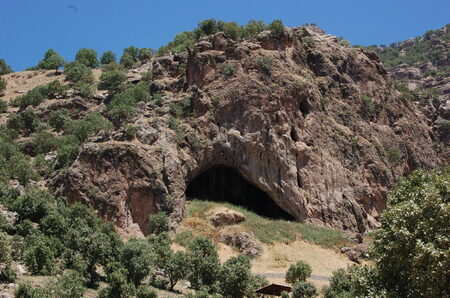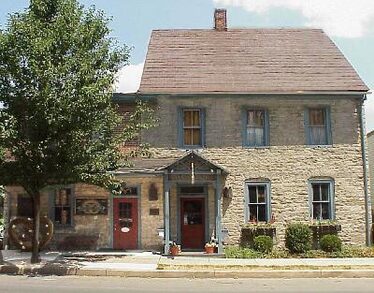Food Historic: Since 1805, Maine Ave Fish Market, DC
Food Historic Sites
Origins
Shanidar Cave, Iraq

Wild date palm seeds dating back 50,000 years have been found in the Shanidar Cave of northern Iraq. The date was the basis of the diet of these early Neandertal cave dwellers and essential to their well being in other ways. Its leaves provided shade from the sun and shelter from dust storms.
The date palm may well be the world's oldest food producing plant. A native of what is now Iraq, the date, or Phoenix dactylifera, is a member of the Palm family, a group of trees with no branches, topped by large crowns of leaves, each leaf from 10 to 20 feet in length.
Growing rapidly, as much as one foot per year, and as high as 80-100 feet, the date palm appreciates having its feet in the water and its head in the sun, not unlike a duck. It thrives naturally, therefore, in oases. These are typically dry, warm places of little rainfall but an adequate underground water supply.
Thousands of years ago, the date palm grew in such natural places, when people were still following herds of wild animals and gathering plant foods to eat each day.
Bakeries/Breweries
Julius Sturgel Pretzel Bakery, Lititz, PA
"In 1850, Julius Sturgis ran a bread bakery in Lititz, Pennsylvania. Legend has it that a hobo who had hitched a ride on a train that ran behind the bakery followed the smell of freshly baked bread, looking for a job and something to eat. Julius couldn’t offer the man a job,but he extended his hospitality and invited the hobo to sit down at the family dinner table. In exchange for the kindness, the hobo gave Julius a pretzel recipe.
 As with most legends, this one contains very little actual fact. We’re not sure how the story came about, but we do know that in 1861, after eleven years as a baker, Julius stopped making bread and established the first commercial pretzel bakery in America."
As with most legends, this one contains very little actual fact. We’re not sure how the story came about, but we do know that in 1861, after eleven years as a baker, Julius stopped making bread and established the first commercial pretzel bakery in America."
Kitchens: Bake Like the Colonials Did, At Jamestown Settlement
Eateries/Drinkeries: When In New York, George Favored Fraunces Tavern
 One of the most genuine and deeply George Washington-invested eateries is in Manhattan, Fraunces Tavern, on Pearl Street. Established in 1762, the tavern was a social gathering point that later became the spot where pre-Revolutionary War patriots exchanged news, where spies dallied, and where General Washington famously said goodbye to his officers at the end of the War in 1783. The Tavern museum, upstairs from today's restaurant, recreates the rooms of the era.
One of the most genuine and deeply George Washington-invested eateries is in Manhattan, Fraunces Tavern, on Pearl Street. Established in 1762, the tavern was a social gathering point that later became the spot where pre-Revolutionary War patriots exchanged news, where spies dallied, and where General Washington famously said goodbye to his officers at the end of the War in 1783. The Tavern museum, upstairs from today's restaurant, recreates the rooms of the era.
According to the museum website, "After the war, when New York was the nation’s first capital, the tavern was rented to the new government to house the offices of the Departments of War, Treasury and Foreign Affairs."
Today the 21st c. eatery and drinkery Fraunces Tavern is run by the Porterhouse Brewing Company.
Disappearing Eateries: Lithuanian Chicago
Food historic sites by category
Origins
Farms and Ranches
Markets
Kitchens, Dining Halls
Orchards, Groves, Vineyards
Eateries/Drinking Spots
Bakeries and Breweries
Processing Sites
Fishing-Related Undertakings
Corporate Locations
Places associated with famous foodies/famous recipes
Writing Food Memoirs
My Food Memory-- Send Us Yours!

An unforgettable main street shop where I grew up was McClintock's Bakery. In my memory it was a magical glass and mirrored source of sugar-laced buttery pastries, layer cakes and fresh seasonal fruit pies. I was fascinated with the precision of the operation. All the cakes and Danish pastries were made on the premises. Customers took a number and waited. The no-nonsense sales women wore white dresses with lace hair nets. Layer cakes were carefully placed in tall set-up boxes, pies and pastries in flatter ones stacked on top. Each was tied shut using string that hung down over the counter from huge spools suspended from the ceiling. Donuts and cookies were bagged. Croissants were unheard of. Customers paid in cash, didn't linger to chit-chat and departed with a stack of white boxes and pastry bags.
Tom Hughes